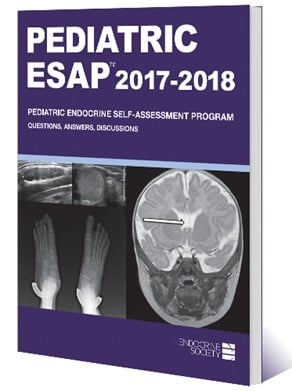
This case highlights the newest edition of Pediatric Endocrine Self-Assessment Program (Pediatric ESAP). Test your clinical knowledge and prepare for your exam. Available on the online store.
Clinical Vignette
You are called to consult on a 12-year-old girl who was hospitalized after presenting with abdominal pain, vomiting, and constipation.
Laboratory test results:
Calcium = 15.2 mg/dL (3.8 mmol/L) (reference range, 8.8-10.8 mg/dL [2.2-2.7 mmol/L])
Creatinine = 1.8 mg/dL (159.1 µmol/L) (reference range, 0.5-1.0 mg/dL [44-88 μmol/L])
PTH = <3 pg/mL (<3 ng/L) (reference range, 10-55 pg/mL [10-55 ng/L])
Total 25-hydroxyvitamin D = 210 ng/mL (524.2 nmol/L) (reference range, 20-50 ng/mL [5-125 nmol/L])
Renal ultrasonography shows medullary nephrocalcinosis. You diagnosis hypervitaminosis D and obtain additional history from the child’s parents. The family has recently relocated to the area from southern California. They state they are very health conscious and eat only organic food. They describe their daughter as a “big milk drinker” who consumes 6 glasses per day of unpasteurized milk purchased from the local farmers market. The family homeschools and does not own a TV; the patient spends multiple hours playing outdoors each day. She takes no medications, but she does receive a cod liver–based supplement purchased from a local naturopathic shop. You read the label on the supplement, which states that the recommended dose of 3 pills daily contains a total of 4000 IU of vitamin D3. The parents insist they have followed the instructions on the label consistently.
Which of the following is the most likely cause of this patient’s hypervitaminosis D?
- Excess consumption of unpasteurized milk
- Excessive sunlight exposure
- A mutation in the CYP24A1 gene encoding 24-hydroxylase
- The parents are not being truthful about the amount of supplement they are administering
- The supplement contains higher amounts of vitamin D than is indicated on the label
SEE CORRECT ANSWER AND EXPLANATION
Answer: E
The supplement contains higher amounts of vitamin D than is indicated on the label
This patient’s presentation with hypercalcemia, hypercalciuria, and PTH suppression is characteristic of hypervitaminosis D. The Endocrine Society has proposed that vitamin D intoxication be defined as 25-hydroxyvitamin D levels exceeding 150 ng/mL (374.4 nmol/L) and that levels below 100 ng/mL (249.6 nmol/L) be considered safe for children and adults. Most cases of hypervitaminosis D result from high doses of vitamin D supplements. This may be due to insufficient medical monitoring of supplement intake, or rarely from mislabeling of supplement contents. FDA regulations for dietary supplements are less stringent than for prescription or over-the-counter medications. Unlike medications, supplements do not require premarket review or FDA approval before being sold to consumers. Companies that produce supplements are required to have evidence that products are safe and accurately labeled; however, this evidence does not need to be provided to the FDA before marketing. This has led to cases of incorrect labeling and dosing, including reports of hypervitaminosis D in the United States and other countries. Therefore, the most likely cause of this patient’s hypervitaminosis D is that the supplement contains higher amounts of vitamin D than is indicated on the label (Answer E). The 2011 Endocrine Society Clinical Practice Guidelines endorse the following tolerable upper limits for daily maintenance therapy: 1000 IU daily for infants up to 6 months, 1500 IU daily for infants from 6 months to 1 year, 2500 IU daily for children aged 1 to 3 years, 3000 IU daily for children aged 4 to 8 years, and 4000 IU daily for individuals older than 8 years. Vitamin D toxicity would therefore be unlikely if this patient were truly receiving 4000 IU per day as indicated on the label. It is possible that the family is being untruthful regarding the amount of supplement they are administering (Answer D), but this is less likely.
In the United States, cow’s milk is routinely fortified with vitamin D as part of the manufacturing process. The specific vitamin D content of fortified milk may be variable, but it is typically on the order of approximately 120 IU per 8 oz, making it very unlikely to develop hypervitaminosis D from milk consumption alone. Additionally, this patient is consuming unpasteurized milk, which has not been subjected to the fortification process and is not a natural source of vitamin D (thus, Answer A is incorrect).
Excessive sunlight exposure (Answer B) does not cause hypervitaminosis D. With high levels of sun exposure, vitamin D precursors in the skin ultimately reach a steady state, and any additional vitamin D that is produced is degraded. Loss-of-function mutations in the CYP24A1 gene (encoding 24-hydroxylase) (Answer C) lead to hypercalcemia by decreased degradation of 1,25-dihydroxyvitamin D. Affected patients may present in infancy with symptomatic hypercalcemia in response to vitamin D supplementation, termed idiopathic infantile hypercalcemia. In this condition, 25-hydroxyvitamin D levels are typically normal or low, while 1,25-dihydroxyvitamin D is inappropriately elevated.
Educational Objective:
Differentiate among the various causes of vitamin D excess and describe the clinical and laboratory manifestations of hypervitaminosis D.
References:
Araki T, Holick MF, Alfonso BD, Charlap E, Romero CM, Rizk D, Newman LG. Vitamin D intoxication with severe hypercalcemia due to manufacturing and labeling errors of two dietary supplements made in the United States. J Clin Endocrinol Metab. 2011;96(12):3603-3608.
Vogiatzi MG, Jacobson-Dickman E, DeBoer MD; Drugs, and Therapeutics Committee of The Pediatric Endocrine Society. Vitamin D supplementation and risk of toxicity in pediatrics: a review of current literature. J Clin Endocrinol Metab. 2014;99(4):1132-1141.
Holick MF, Binkley NC, Bischoff-Ferrari HA, Gordon CM, Hanley DA, Heaney RP, et al; Endocrine Society. Evaluation, treatment, and prevention of vitamin D deficiency: an Endocrine Society clinical practice guideline [published correction appears in J Clin Endocrinol Metab. 2011;96(12):3908]. J Clin Endocrinol Metab. 2011;96(7):1911-1930.


